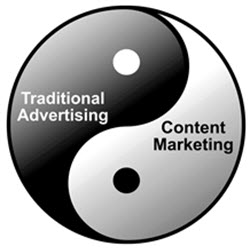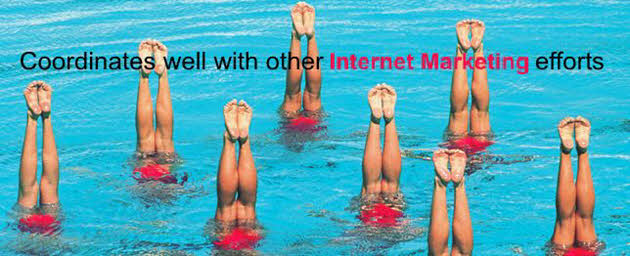Content Marketing or Advertising
 Content Marketing or Advertising
Content Marketing or Advertising
I teach classes on Content Marketing and I notice that people sometimes have a problem distinguishing between advertising and content marketing. I often explain that advertising and content marketing can work together. That advertising helps to make people aware and then if they want to dig in deeper then advertising can hand off to content marketing. Here is an examination of both advertising and content marketing.
Both have their place.
Your Audience
Whether you want to put your efforts into advertising or content marketing you need to know your audience well and you need to be an advocate for your audience. What do they want? What do they need? What do you need to do to attract their attention?
Think about this. Be an advocate for your audience. Work hard for them.
Let’s examine traditional advertising.
Advertising in Context – Many Advertisements are Interruptions
As people within a society, we’re more connected than ever before. This level of connectivity creates a constant stream of interruption and even disruption. If you advertise then you need to attract attention in a clever and engaging way. Do not be a company that creates interruptions be a company that provides solutions?
For advertising to be is effective it needs to attract and build your brand. An example of a very clever ad is the ads of Absolute Vodka. First they played off the distinctive shape of their bottle which was a very unusual shape and a differentiator. They then connected with specific audiences in a very clever and simple way. The simplicity and the connection they made with specific target audiences made people smile.

This is clever and engaging advertising and people were delighted and felt a special connection with Absolut.
Moreover, the ads were attractive and were designed so that the audience did not have to work too hard. Their very first advertisement was simply “Absolut Perfection”. There are no extra words here. It is direct and to the point. It is clever.
Building brand awareness, emphasizing differentiators and making a connection with a specific audience was the key to increasing market share. Absolut sales were 9,000 liters in 1979. In 2012 11.6 cases were sold (over 100 million liters). As another backdrop to this, there was an independent market study performed in 1979 that concluded that no one would buy Swedish vodka. Nevertheless the first shipment was sent to the United States in 1979 and the ads did the rest.
The key to Absolut advertising was to create a desire. It became a premium vodka brand because the brand advertising created this perception. Today, it is an icon. This was superb advertising.
Traditional “salesy” advertising
At one time, sales-y advertising worked, and sometimes it still does. However, the increasing amount of information thrown at us on a day-to-day minute-to-minute basis is staggering and certainly seeks to interrupt us. I have listened to people in my content marketing classes actually refer to the amount of information we are constantly bombarded with as “insane”. If you intend to use traditional advertising you do not want to be lumped into the same category as the advertising that is somehow connected with the concept of “insane”.
You need to catch the attention of your audience with insightful and simple wording, engaging graphics and a consistent message.
Advertising Consistency
“A Diamond Is Forever”
We all know this saying and we repeat it without even thinking about where it came from. It came from DeBeers – the diamond cartel involved in diamond mining, diamond trading and diamond shops worldwide. They have a keen interest in promoting diamonds. They have been a model of consistenc as it relates to their promotion of diamonds and the activity to promote the desire for diamonds.

With this incessant flood of information, we may ignore, and in extreme cases detest advertising attempts.
However, clever advertisement that delivers a clear and consistent message stays with us. I, for one, appreciate a clever ad. I get a kick out of how the creator managed to catch my attention.
Advertising, to be effective, needs to be able to break through the clutter and the barrier of distraction and leave an impression with your target audience. Consistency is important to be able to break through as it may take multiple attempts.
Advertising – It Has Its Place
We need to also realize that advertising has its place. We do need to let people know that we exist or that we have a product or a service that can help them. Great advertising also creates demand. It creates a desire. We have to design our advertising in a way that makes people know that we have a solution to their needs, desires and problems.
I’m a believer that there will always be a place for traditional advertising, but will have to get better to be effective. Good advertising has and will continue to be more than the product or service. It also has to include the people using the product or service – the audience.
Advertising – It Can Be Expensive
Effective advertising is not cheap. To help keep costs inline with your budget consider your audience. Consider wisely where you want your ads to appear. You can place your ads in niche magazines or on particular television networks at specific times (another form of niche). You can set up on a particular social media platform and ignore another. These are choices you need to make and it, again, depends on your audience. For example, if your audience spends time on You Tube then a campaign designed for You Tube makes sense.
You have control over who sees your ads – at least initially.
A part of advertising and marketing is also experimentation.
Here’s my advice: research, experiment and then adjust and modify. If you work in the area of marketing, then you are already familiar with the need to experiment. You must conduct research, experiment, measure and adjust.
Now, let’s examine content marketing.
Content marketing: it’s been around for quite some time and has been gaining momentum over the past few years. If you’re not familiar with the term or concept, here’s a brief run-down of why content marketing is important.
From The Content Marketing Institute . . .
Content marketing is “a marketing technique of creating and distributing valuable, relevant and consistent content to attract and acquire a clearly defined audience – with the objective of driving profitable customer action.”
Content Marketing – It Takes Time
The goals of content marketing will vary, but for a business, the ultimate goal is to sell something. This should not be your only goal but a business needs to make a profit and sales are fundamental. Content marketing can help you do this. However, it will take time and some strategic planning to help guide your audience through the sales funnel with your content marketing efforts.
Content Marketing – Repurposing
One of the strong aspects about content marketing is the variety of “mediums” which can be used for your content. Content can be anything, including blog posts, website content, images, videos, social media posts, ebooks, Slideshares, presentations, infographics, etc. In this light, the possibilities of content marketing are nearly endless.
Content Marketing – Not a Sales Pitch
Content marketing is (or at least should be) much more subtle than advertising. At its core, content marketing should educate, inform and entertain your audience. Within your content marketing materials, you’ll want to create an “Oh By The Way” Moment – this is where the selling comes in or the “suggestion” of selling.
This “moment” happens when your content addresses your audiences’ problems, answers their questions, or simply provides them with information. You need to make it clear that YOU can provide excellent answers and delightful solutions through your products and/or services.
Content Marketing – It Needs to Compete for People’s Time
While subtlety and quality content works to build loyalty, content marketing is not without its challenges. As I mentioned above, the amount of information thrown at us on a minute-to-minute basis is excessive, and it makes it that much more difficult for people to sift through “the noise” to find your delightful treasures (which is what your content should be).
Content Marketing – It Works Well on the Internet
Competing on the Internet requires skill and dedication of effort. It isn’t impossible and can be rewarding. You must make your efforts unique, memorable, consistent and valuable. Content marketing is tricky, and what works for one brand might not work for another. It not only takes time to create and distribute quality content, but it can also take a significant amount of time to see an ROI (return on investment).

However, the Internet is a perfect place for your content marketing efforts. In many ways it is designed for content marketing. The search engines love quality content and you will be rewarded with better search performance as a result of your efforts.
Content marketing shines over advertising when it comes to supporting or enhancing search position.
Content Marketing – Less Expensive than Advertising
Compared to traditional advertising, content marketing is much more reasonably priced (with some exceptions, of course and it is certainly not free). For example, what you could spend on one advertising campaign and placement can be used to create a variety of content marketing pieces and campaigns. The content can be used across many social media platforms, including Facebook, Twitter, YouTube, Pinterest, Instagram, LinkedIn, etc.
I think that individuals and businesses will start to realize the value of content marketing and with good reason. Content marketing is a great way to market your products and/or services. Those businesses that start earlier will have an advantage over those that start later.
Here is some guidance on getting started with your content marketing efforts.
1. Research: Like all marketing initiatives, you’ll want to begin with some research. Some questions you should answer include:
- Who is your target audience?
- Where does your audience spend their time?
- What kind of information does your audience seek?
- What kind of content does your audience find entertaining?
- Who are your competitors?
- What are your competitors doing?
- How is it working for your competitors?
- How can you do it better than your competitors?
2. Start Small: When you have a limited budget, choose your content marketing endeavors carefully. To establish and reinforce your brand’s voice and personality, start by adding a blog to your website. Decide how often you can post and stick to that. Base your blog posts on the research conducted in step one.
3. Become Social: If you’re not already on social media, get on it! Figure out where (which platforms) your audience is present and start listening, responding and engaging with them. Share the content from your blog and see what types of content earn the most attention and results. This will help you determine what your audience likes, which will help determine the best type(s) of content to create.
4. Be Consistent: Whether you’re going to post daily, weekly or monthly, be consistent! I’m a true believer in quality over quantity, and while you may see more results quicker with more content, if it’s not quality content, it could hurt you.
5. Track Results: Google Analytics is a great resource to track the success of your blog posts, and you can even set it up to track social media conversions. The social platforms also have their own analytics, which show what posts are most successful, how many clicks they receive, how many shares, etc.
6. Start Thinking Bigger: As you dive into content marketing with blogging and social media, start thinking of more in depth projects such as ebooks, infographics and videos. While these are more intensive, they’re valuable ways to attract visitors, leads, and social media enthusiasts. This content not only helps keep you in your customers’ minds, but it’s also great for remarketing purposes.
The Final Answer: Content Marketing or Advertising?
I can’t tell you whether you should invest in content marketing or advertising. That’s still a decision you’ll have to make for your business. Both have their pros and cons, as with anything in life. You should really think about how to use both to position your business and brand as a problem solving operation.
Oh, by the way, if you’ve been investing in advertising and have some experience with it and are not seeing the results you’d hoped for, you might want to try content marketing. Provide your audience with content they can use and share – it’ll help grow your business. Alternatively, try a mix of content marketing and advertising. After all, you’ll never know what works best until you test it out!
Whichever route you choose, I advise that you fully understand your audience and seek to provide solutions to their problems.
It you want to learn more about content marketing then I invite you to take our Content Marketing Tutorial Series. It will help you to learn about this marketing approach. This is an educational series on Content Marketing – enjoy!
